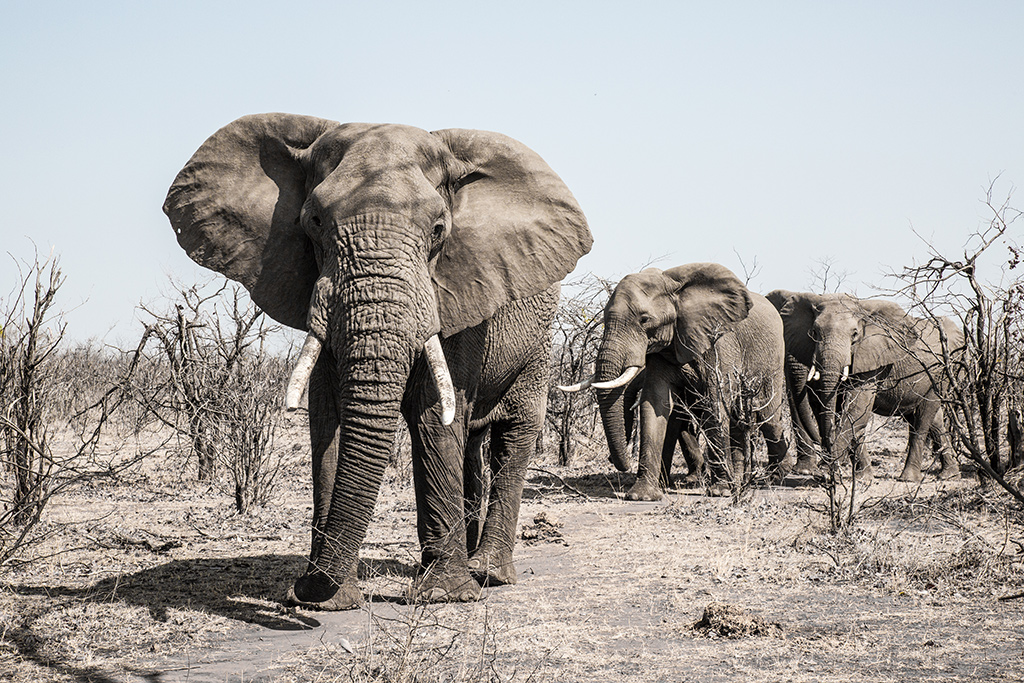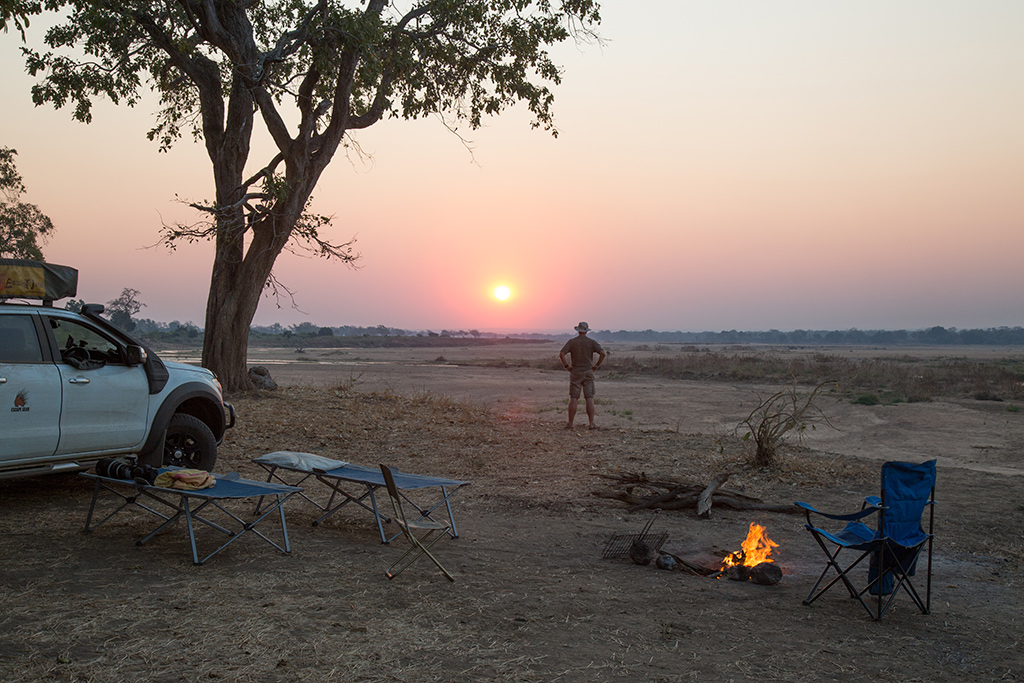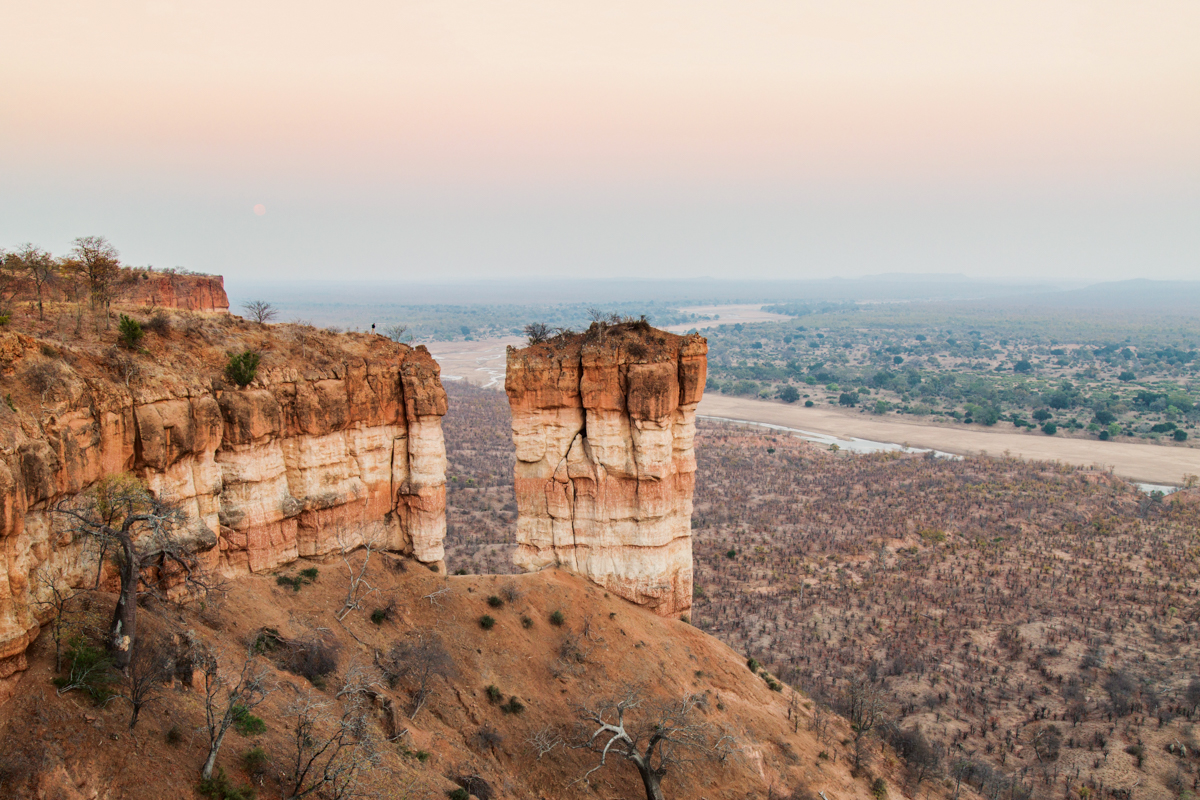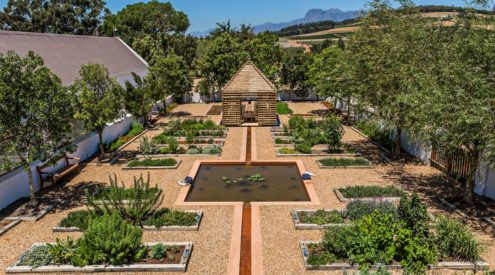The success of Gonarezhou National Park has placed it in the same league as Mana Pools, Kaokoveld and the Okavango. A genuine wilderness area with teeming wildlife, unique landscapes and a self-drive haven for 4x4s, Scott Ramsay lists the four best reasons to visit this evocative national park in south-eastern Zimbabwe.
1. That goosebump wilderness feeling
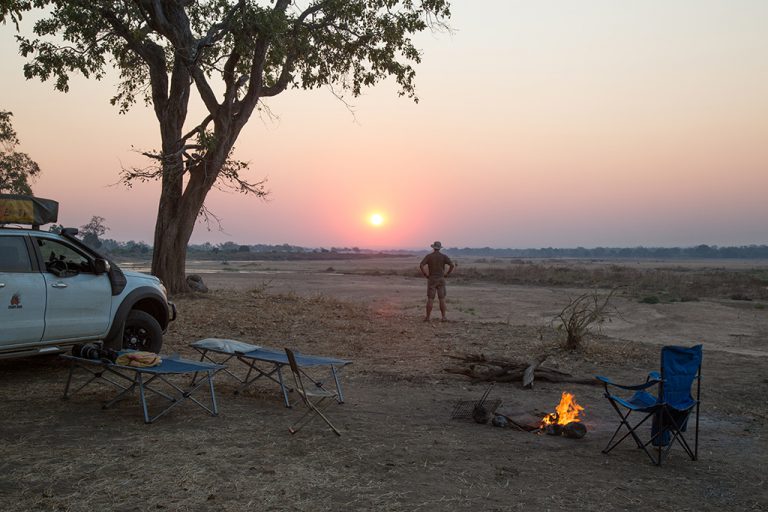
Chamaluvati campsite is little more than a GPS co-ordinate and long-drop toilet. Perfect… it’s also unfenced, like all the others in the park. Photo by Scott Ramsay.
We’d set up camp near the base of the Chilojo Cliffs, where the broad Runde River turns north to meet the Save River. Tired from the hot day, we drank cold beers and sizzled our meat on a mopane wood fire. Soon we fell asleep on our stretchers under a sparkling celestial ceiling. But not for long. The night’s silence was cracked wide open by a succession of baritone roars. My deep dreams ended abruptly as adrenaline surged through my body.
I shone a torch in the direction of the sound. A large male lion stood 30 metres away. Slowly he walked towards us with predatory entitlement. We quickly stoked the fire and flames shot into the sky. The big cat stopped a few metres away, then fortunately lost interest and walked down into the dry riverbed, leaving us for the night.
Sleep came surprisingly easily again, and at dawn we woke to three elephant bulls feeding on branches of a nearby apple-leaf tree, the leaves falling like confetti around us. Unlike the lion, the elephants ignored us and focused on their breakfast. I lay in my sleeping bag and watched them, then turned to admire the first rays of sun bursting into the sky above the Chilojo Cliffs. The red sandstone ramparts are spectacular, and shone luminously in the early morning light.
It’s these visceral interactions with wilderness that make a visit to Gonarezhou special – and rare, in this increasingly commercial era of wildlife tourism. The park lies just across the border from well-trodden Kruger in South Africa, but it’s another world. There are no tar roads, fenced campsites or shops here. The park’s rugged terrain, poor roads and remote location give it an aloof allure. It’s a difficult place to get to, and to explore. Damn right. But it’s worth it.
2. Wildlife numbers are booming
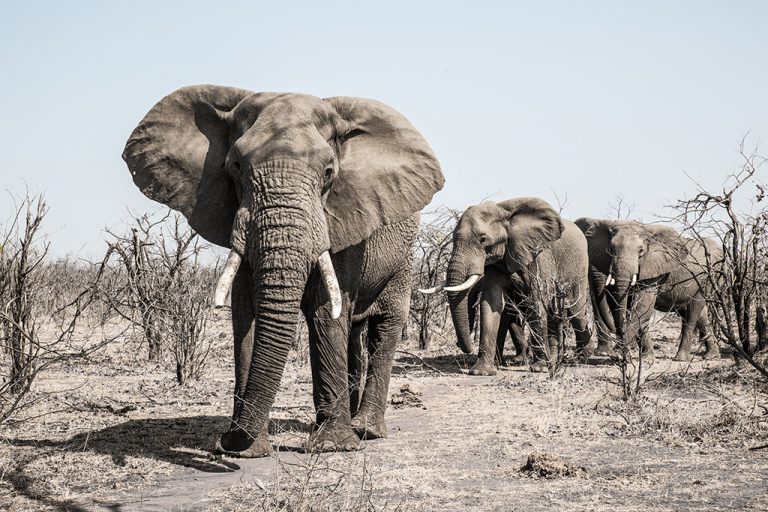
Gonarezhou’s 11000 elephants epitomise the park’s resurgence, more than doubling in number in the past decade. Photo by Scott Ramsay.
For decades Gonarezhou was considered too remote, virtually inaccessible to tourists. Besides, visitors want to see animals, and most had been shot out by hunters and poachers. But today, wildlife numbers here are booming.
The name Gonarezhou is generally accepted to mean ‘place of the elephant’, an apt description of this brooding lowveld region of Zimbabwe. The 2014 aerial survey counted just over 11000 in the park, up from 4000 in 1994. Gonarezhou has more elephants than the whole of Mozambique, and one of the highest densities in Africa (at about two per square kilometre). And it gets better: the tuskers of Gonarezhou are the biggest in Zimbabwe, clearly sharing DNA with the famed large bulls in Kruger.
In 1979, Kabakwe was the legendary bull that was the first to be given special legal protection from hunting. One of the biggest of recent times (tusks of 45 kilograms each) was shot in the Malapati hunting area adjacent to Gonarezhou in October 2015. So the bulls with big ivory are still here, only there used to be far more of them.
Gonarezhou is not just about elephants. In 10 days we saw lion four times and heard their roars most nights, as well as the howls of spotted hyenas. We also saw a pack of seven wild dogs and several pups; Gonarezhou has one of the strongest populations of these endangered carnivores, a dozen packs.
‘I never saw a lion or leopard for the first three years here,’ says Hugo van der Westhuizen, the park’s conservation manager for the past decade. ‘You’d wake up early in the morning and
there were hardly any animal sounds. It was depressing.’
Now, thanks to stringent anti-poaching measures, the animal statistics makes for reassuring reading. The last predator survey in 2015 showed that there are approximately 125 lions, up from just 31 in 2009. Other predators have also increased significantly: 642 spotted hyenas (from 407), 279 wild dogs (from 30) and 90 cheetahs (from 22).
All herbivore species have increased significantly too. At the last count in 2014, there were 8000 impalas, 1700 kudus, 6000 Cape buffaloes, 1300 Burchell’s zebras, 900 wildebeest, 500 giraffes and 500 hippos. Roan and sable have never recovered to former levels, and black rhinos and Lichtenstein’s hartebeest are now locally extinct, but on the whole things are much better. If all goes to plan, the increase in tourism revenue will allow the reintroduction of rhino, which Hugo says could happen as soon as 2018.
3. A sense of place
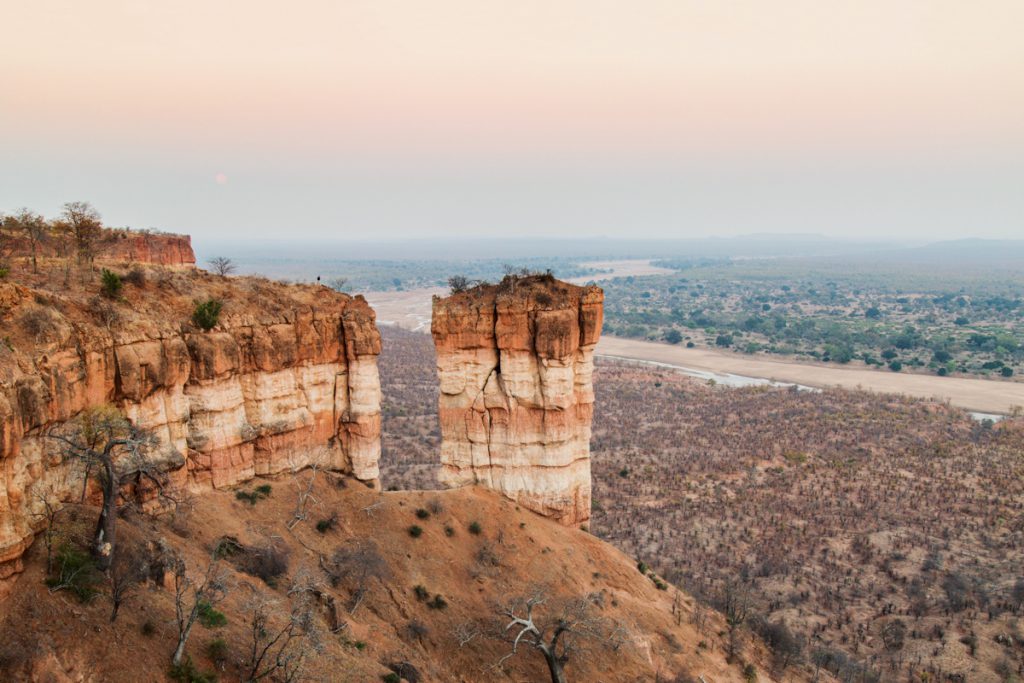
One evening we camped at Chilojo Cliffs during a full moon, and in the morning we watched our planetary sibling drop below the horizon. Photo by Scott Ramsay.
Mana Pools has its albida forests alongside the Zambezi River. Gonarezhou’s Chilojo Cliffs elicit a similar sense of wonder. Rising 200 metres above the floodplain of the broad Runde River, the 13-kilometre sandstone rampart is magnificent. It’s the defining feature of this remote wilderness.
Here the Runde flows south and seems to bump into the cliffs, then has to flow north to meet the narrow, powerful Save. Together, these rivers give the northern part of the park a unique sense of place. From the top of the cliffs, Gonarezhou’s diverse landscapes are clear to see. Most obvious are the extensive floodplains alongside the Runde, which reminded me a little of those at Mana Pools at the opposite end of the country. The large Tembwahata Pan lies near the confluence of the two rivers and draws plenty of elephant, buffalo and other wildlife during the hot days. The nearby and smaller Machaniwa Pan is just a few hundred metres south of the Runde River, and a superb place for spotting saddle-billed storks and fish eagles, who prance around the muddy waters scooping up unlucky catfish.
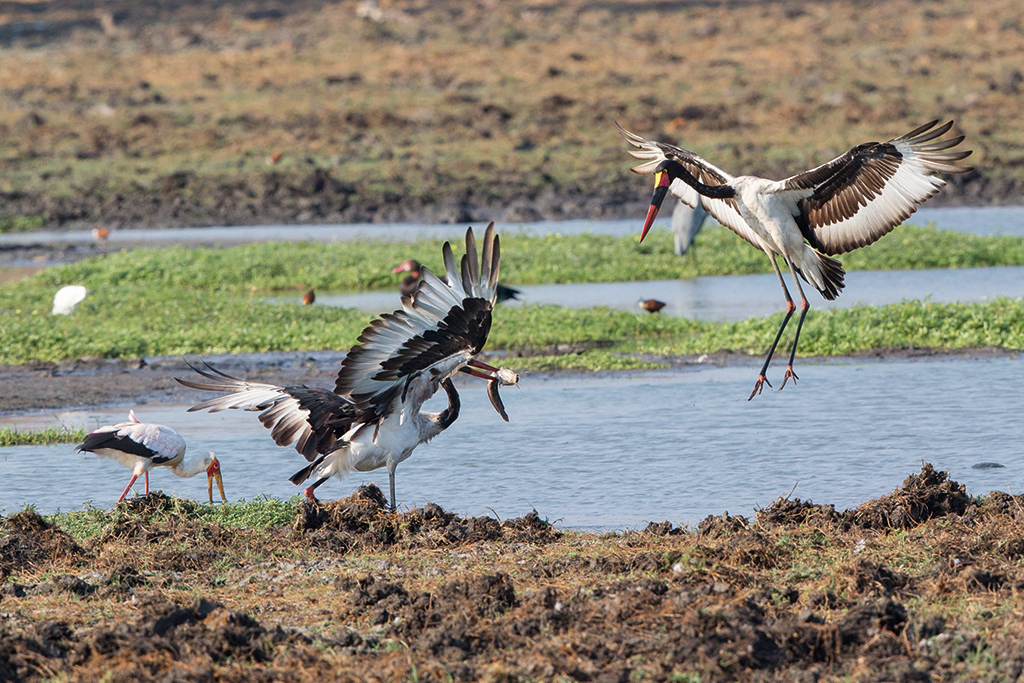
During the dry season, two pans offer fantastic sights. Machaniwa Pan is an excellent environment for birding in particular, with good numbers of saddle-billed storks. Photo by Scott Ramsay.
Vast mopane woodland dominates the basins and plateaus on either side of the Runde. The scene is grand. ‘Gonarezhou has diversity of habitat that most other parks don’t have,’ says private guide Anthony Kaschula, who has been running a mobile campsite here since 2009. Few know Gonarezhou better than he.
‘On a typical five-night safari you’ll see rocky gorges and waterfalls, impenetrable ironwood forest with floodplains and pans, big swathes of mopane and huge areas of sandveld woodland. You’ve got the Chilojo Cliffs themselves and wide, sweeping sand rivers. It’s incredibly diverse, and very photogenic.’ The park could also be Africa’s epicentre of baobabs. There are thousands of these arboreal grandfathers. Near Tembwahata Pan, we counted 60 within sight of us.
4. Not a tourist in sight (almost)
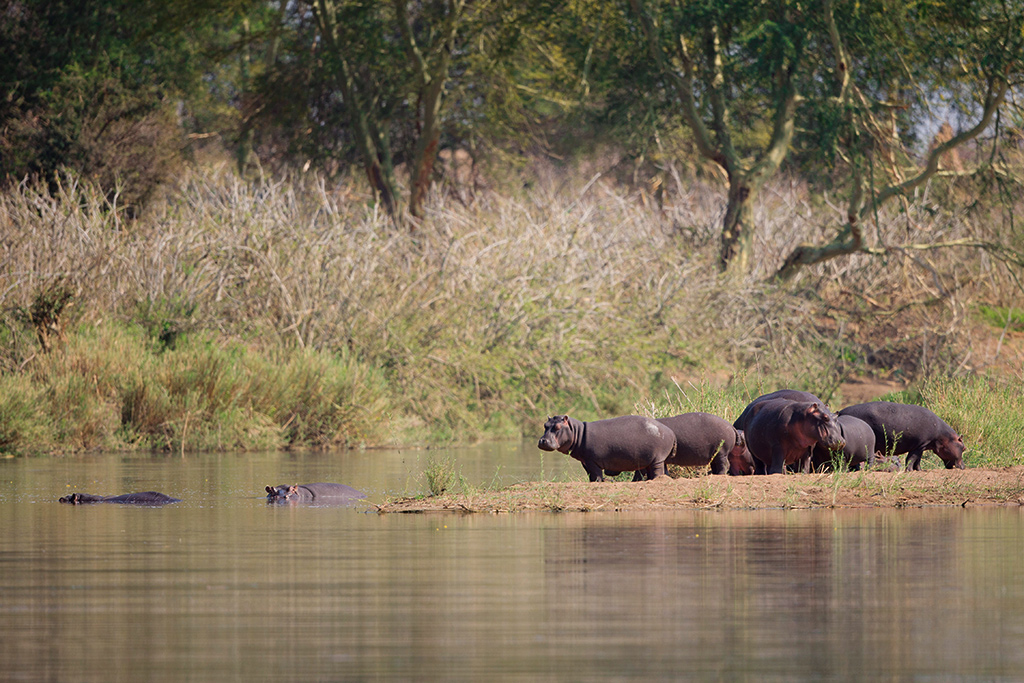
Hippos congregate during the heat of the day in deeper water of the rivers, but in the cool early mornings you’ll find on the sandbanks warming up. Photo by Scott Ramsay.
Anthony believes Gonarezhou’s best feature is its lack of tourists. ‘It’s still off the tourism map. While there are other places in Africa that are also very wild, many of those are overrun with visitors.’ There are only three camps in this 5 000-square-kilometre park, with tented chalets or ‘developed’ campsites offering basic thatch-and-stone shelters and ablutions. The rest are just GPS co-ordinates on a map, with a long-drop toilet, and can only be used by one group at a time. All of these, 26 in total, are far from each other.
‘We think Gonarezhou is a secret success story,’ Hugo told me in his office at Chipinda Pools, near the northern entrance to the park. ‘But please, don’t tell that to anyone!’
About 7000 visitors come to the park annually. This may seem paltry compared to Kruger’s one million, but just a decade ago almost no one visited. ‘Don’t get me wrong, I’m happy tourists are returning,’ he said, ‘but we didn’t anticipate how quickly this place would turn around.’
Near the end of our 10-day visit, Hugo and his wife Elsabe invited us to camp with them at the top of the Chilojo Cliffs. As the elephants have done every night in winter for thousands of years, they descended the escarpment via one of the few passes to quench their thirst at the Runde River below. The full moon rose. In prayerful silence we stood on top of the cliffs and watched several breeding herds negotiate the steep pass below us. A warm wind picked up and carried our whispers and wood-fire smoke away from the matriarchs.
These elephants were doing what they’ve always done, oblivious to our presence. At Gonarezhou, you get the feeling that the animals are in charge. And as parks go, it is once again one of Southern Africa’s finest.
Why it’s a success story

The central and south-western sector is where most of the park’s wild dogs roam. Photo by Scott Ramsay.
Long before Gonarezhou was a conservation area, elephant hunters shot what they wanted. In the 1960s, to rid the area of tsetse fly – which infected cattle and people with nagana (sleeping sickness) – huge tracts of riverine and ironwood forest were bulldozed. So too were many of the natural pans that had taken centuries to form. Thousands of wild animals were shot, including buck, buffalo and elephant. The land was enclosed with wire fencing and sprayed with pesticides such as dieldrin and DDT.
Just as it was finally proclaimed a national park in 1975 and wildlife populations had started rebuilding naturally, the Mozambican civil war began. To feed themselves, soldiers set thousands of snares using wire from the fences. In addition, almost 10000 elephants were culled over the course of two decades by authorities concerned about habitat damage.
The park has an unfenced 110-kilometre border with Mozambique, where nine hunting concessions are interspersed with poor communities desperate for protein. Snare poaching and poisoning used to be rife. Some game farms were placing bait and water close to the boundary, drawing predators, elephants and other wildlife across into Mozambique for safari hunting. Zimbabwe Parks & Wildlife receives no subsidies from the government, so revenue from safari tourism is crucial. With dwindling wildlife and visitor numbers, funding had dried up.
In 2010, the Frankfurt Zoological Society (FZS) signed an agreement with Zim Parks to support the park for 20 years. The team that had already successfully implemented measures to resuscitate the wilderness were tasked with continuing their good work: conservation manager Hugo van der Westhuizen, his ecologist wife Elsabe, area manager Evious Mpofu and other colleagues from Zim Parks. FZS now pays almost all operational costs: staff salaries, training and rations, vehicles, diesel, aircraft, aerial surveys, vegetation mapping, anti- poaching and the construction and maintenance of all roads, fences and tourism facilities.
The latest cause for celebration is the recent creation of a trust, made up of both FZS and park officials, that will control Gonarezhou. As trust director, Hugo will have the final say on all park management and tourism infrastructure decisions. And crucially, all tourism money generated (about $400 000 currently) will from now on be invested back into the park. Previously, it had disappeared into central state coffers and Gonarezhou hardly benefitted.
‘This is groundbreaking stuff,’ says Hugo. ‘The park is now run by a true partnership, and it’s up to us entirely to make even more of a success, which I’m confident we will do.’
Plan your trip
Getting to Gonarezhou National Park
Gonarezhou can be reached from South Africa in two ways. During dry season, the more adventurous route is through the north of Kruger National Park, accessing first Mozambique at the Pafuri border post and then crossing the Limpopo River, following the Zim-Moz border to the Chicualacuala border post. From here, cross into Zim and you’re in Gonarezhou.
Make your way north to Boli Village, then turn east to the Chipinda South Gate, which is near the main HQ of the park. During wet season, the only way to get to the park is via the Beitbridge border post. From there, drive north to Ngundu, then east to Chiredzi, then south to Chipinda Pools. If you’re heading to the park from Harare, take the A10 road to Chiredzi Town, then east to the turn-off that heads south to Chipinda North Gate.
When to go
Winter and spring is the dry season (from May to October), when the park is most accessible for self-drivers. During the summer wet season, the Limpopo, Runde and Save Rivers are in flood, so access to certain areas of the park will be restricted (even in July or August, the Save River can be flooded, so aim to travel to Gonarezhou around September or October).
Need to know
Independent travel in Gonarezhou is only for fully self-sufficient 4x4ers and experienced bushwhackers (think unfenced campsites with wild animals close by). It takes a long time to get anywhere due to the bad roads. Crossing rivers can be tricky – even if they’re dry, beware of thick sand. There is nowhere to buy food, water or drinks in the park (the nearest town for supplies is Chiredzi), although you can buy firewood at the entrance gates and at Chinguli camp. Needless to say, there is no cell- phone reception.It is a malaria and bilharzia area, so take precautions. You will need to pay conservation fees (R78 per person per day), camping fees (R390 per person per night) and vehicle fees (R130 for five days).
Stay here
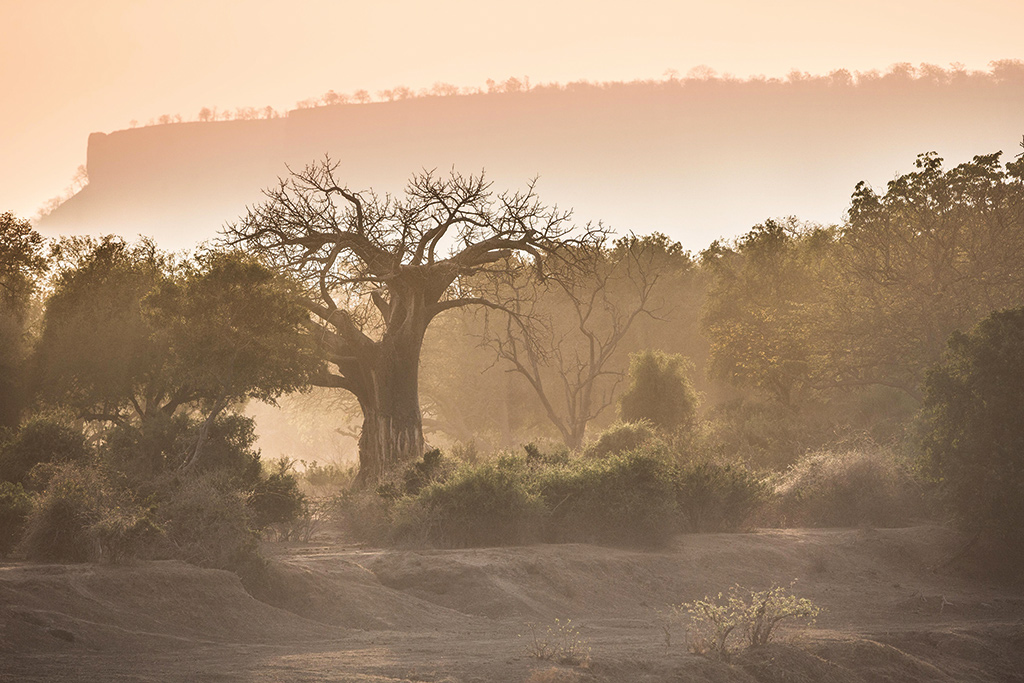
Early morning at Hlaro campsite, looking across the Runde River. Elephants love the soft trunks of baobab trees, and there are plenty here to snack on. Photo by Scott Ramsay.
Chipinda Pools, near the park’s northern entrance, has four tented en-suite chalets with kitchens (sleep four to six). There are also nine campsites with thatched gazebos and communal ablutions.
Chinguli, near Chilojo Cliffs, has similar camping facilities. There are five sites here; only six people and two vehicles per site.
(The third camp, Swimuwini, which I did not visit, is in the far south-west and has nine chalets.) The best campsites are the ‘exclusive-use’ ones in the north-east of the park, on either side of the Runde River – my favourites are Hlaro, Chilojo and Chitove. Maximum 12 people and three vehicles; the only facilities are long-drop toilets. Campsites R650, exclusive campsites R1171, self-catering chalets from R1119 for two. Visit zimparks.org for more info.
Chilo Gorge Lodge, not in the park itself but on the edge of it, is built on a ridge so it has superb views over the Save River and into Gonarezhou. It has self-catering villas (sleeps two) and a family villa (sleeps six) at Nhambo Camp, with a shared kitchen, braai area and plunge pool. The main lodge is more luxurious, with a pool, library and bar. From R1301 self-catering for two, R3249 for the family villa, R1949 per person for full-board luxury room (SADC rates) plus community and park fees from R155 per person. Fly-in safaris are an option.
Gonarezhou Bush Camp is private guide Anthony Kaschula’s mobile camp, on the banks of the Runde River, which looks out onto the Chilojo Cliffs – you can’t ask for a more stunning setting. It’s ideal for those who want a single-group, fully catered experience. It has just five twin tents, with hot bucket showers and bush toilets. R20783 per person (children R15621) for four nights minimum, including meals, drinks, transfers and guided activities.
This story first appeared in the April 2017 issue of Getaway magazine.
Our April issue features a guide to the Otter Trail, the sunniest roadtrip in SA, and 12 awesome farmstays.










